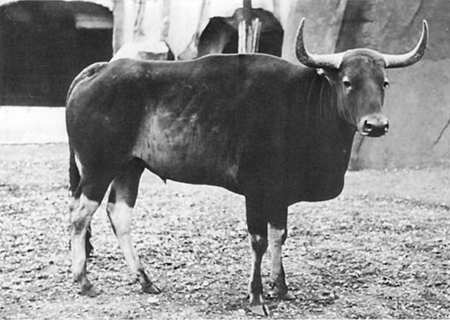kouprey, grey ox (Bos sauveli) Description
A young male Kouprey, the horns not yet fully developed, photographed 1937 at the Zoo of Vincennes, Paris.
Source
Originally published in Urbain, A.; Rode, P.; Pasquier, M.A.: "La collection des bovinés asiatiques du Parc zoologique du Bois de Vincennes", pp. 122-125 in Mammalia, vol. 3 (1939), on the plate between pages 124 and 125. This copy scanned from Nowak, R.M. (ed.): Walker's Mammals of the World, 6th ed., Johns Hopkins University Press, 1999, ISBN 0801857899.
Date
1937
Author
Georges Broihanne according to the original publication in Mammalia 1939. Georges Broihanne was alive in 1953 (photo of his dated to that year published in Mammalogical information http://books.google.com/books?id=aK0HAQAAIAAJ&q=%2B%22broihanne%22&dq=%2B%22broihanne%22) and died in 1968.
Source: https://en.wikipedia.org/wiki/File:Kouprey_at_Vincennes_Zoo_in_Paris_by_Georges_Broihanne_1937.jpg
A kouprey (Bos sauveli, "wild ox"; also known as kouproh, "grey ox"), is a wild, forest-dwelling bovine species found mainly in northern Cambodia and believed to exist in southern Laos, western Vietnam, and eastern Thailand. A young male was sent to the Vincennes Zoo in 1937 where it was described by the French zoologist Achille Urbain and was declared the holotype. The kouprey has a tall, narrow body, long legs, a humped back and long horns.
Kouprey form small herds led by a female, and graze on grasses, feeding in the forest during the day and in the open at night. They are affected by degradation of their habitat and are hunted for their meat, horns and skull. There are not thought to be many kouprey in existence, and the last confirmed sighting was in 1988. Since then surveys have been done to try to locate the species, but all have failed. The International Union for Conservation of Nature has rated the species as "critically endangered", but it may already be extinct.
Order: Artiodactyla
Family: Bovidae
Subfamily: Bovinae
Genus: Bos
Species: Bos sauveli Urbain, 1937
Synonyms
Bibos sauveli (Urbain, 1937)
Novibos sauveli (Coolidge, 1940)
